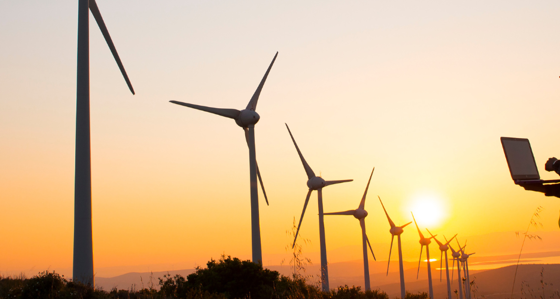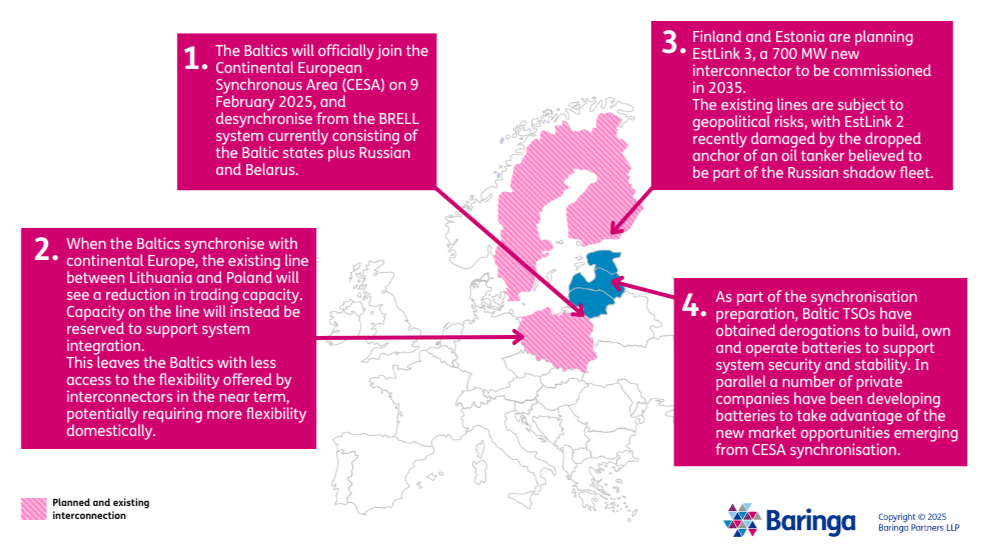
Synchronisation of the Baltic power system with Continental Europe opens exciting opportunities for batteries
4 min read 6 February 2025
On 9 February 2025, the long-awaited synchronisation of the Baltic power system with Continental European Synchronous Area (CESA) will finally complete. Estonia, Latvia and Lithuania will decouple from the Russian and Belarussian system (BRELL) and couple with CESA via the interconnector between Poland and Lithuania, the LitPol link. While this strategically important project will bring benefit to energy security and transition in the Baltics in the medium to long term, there are short-term challenges the region will face.
Baltics will be able to count on the CESA areas for balancing, but will need to procure as well significant volumes domestically – batteries are an important element in this
Commercial exchange over LitPol is currently done through a back-to-back AD/DC converter configuration. Upon synchronization, this will be replaced by a more common two-circuit AC interconnection. It will be critical to ensuring the continued synchronisation of the Baltics with continental Europe, and it allows the Baltics to import balancing energy from abroad. However, as the interconnector will be partly reserved for balancing energy provision, commercial exchange capacity will be reduced. To limit the degree of dependency on the LitPol interconnector for balancing (and thus increase the commercial exchange capacity of the link), the three Baltic transmission system operators (TSOs), Elering, AST and Litgrid, all received exemptions from the EU to install out-of-market flexibility assets (eg batteries in Lithuania) to support system operation (EU regulation prohibits TSOs from owning generation and storage assets unless they obtain derogations in special circumstances). Furthermore, batteries will also play a key role in the part of the balancing reserves which will be procured domestically from the market. Finally, batteries can support the region’s security of supply under special circumstances. The recent incident on Estlink 2 in December 2024, where the Finland-Estonia power cable was damaged by dragged anchor (accidently or deliberately), was the latest example of the vulnerability the region faces.
The Baltics will see significant increase in renewable penetration, potentially pushing up price volatility, creating arbitrage opportunities for batteries
The Baltic region has seen an explosion of renewable investments, driven both by the relatively attractive power prices in the spot market but also an underlying policy drive to improve security of supply and further decarbonisation of the region. In addition, as the LitPol interconnector is repurposed to support synchronisation with continental Europe, trading capacity between Lithuania and Poland will reduce significantly, leading to less flexibility for the region via transmission links. This, combined with rapidly rising renewable deployment, could create additional volatility in the day-ahead, intraday and reserve markets. Batteries are well placed to capture these arbitrage opportunities.
Despite the relatively small size of the Baltic markets, batteries offer an exciting investment opportunities for strategic and institutional players, due to the unique challenges facing the region. State aids are also approved, for example in Lithuania, to support battery deployment through CAPEX grants. In order to get comfortable with the storage opportunities presented by local and international developers, investors need to develop an understanding of the following topics:
- What is the underlying policy and market drivers of the battery market
- How deep is each market (energy & balancing) and how rapid will each of the markets saturate
- How to forecast reserve prices, given there is no prior history of these reserves (price and volume)
- What are the near-term revenue opportunities versus the long term sustainable value drivers
Baringa provides flexibility market outlook for the Baltic region. It covers the current state of BESS assets, the regulatory framework, available schemes for developers, and long-term projections of potential revenue streams across different power markets.
Find out more about the report and the risks and opportunities for investment, by contacting Yinfan Zhang or Janus De Bondt.
Subscribe to our Baltics Flexibility Market Report, complete this form and we'll be in touch.
Related Insights

Renewables Market Scanning Report
Which are the most attractive markets for investing in renewable assets globally?
Read more
How can investors and developers capitalise on South Korea’s evolving energy market?
South Korea's energy market is transforming in line with the global shift to renewable energy.
Read more
How ‘Equipment-as-a-Service’ models unlock commercial decarbonisation
Read our latest piece, created in collaboration with Tallarna, to explore the components of an ‘Equipment-as-a-Service’ model, how they can be deployed, and how to increase take-up.
Read more
Balancing investor demands and competitiveness in Australian Storage CIS tenders
Given the potential scale of the CIS, storage market participants must refine strategies, governance, and bids for the market's new largest storage contract buyer.
Read moreIs digital and AI delivering what your business needs?
Digital and AI can solve your toughest challenges and elevate your business performance. But success isn’t always straightforward. Where can you unlock opportunity? And what does it take to set the foundation for lasting success?
